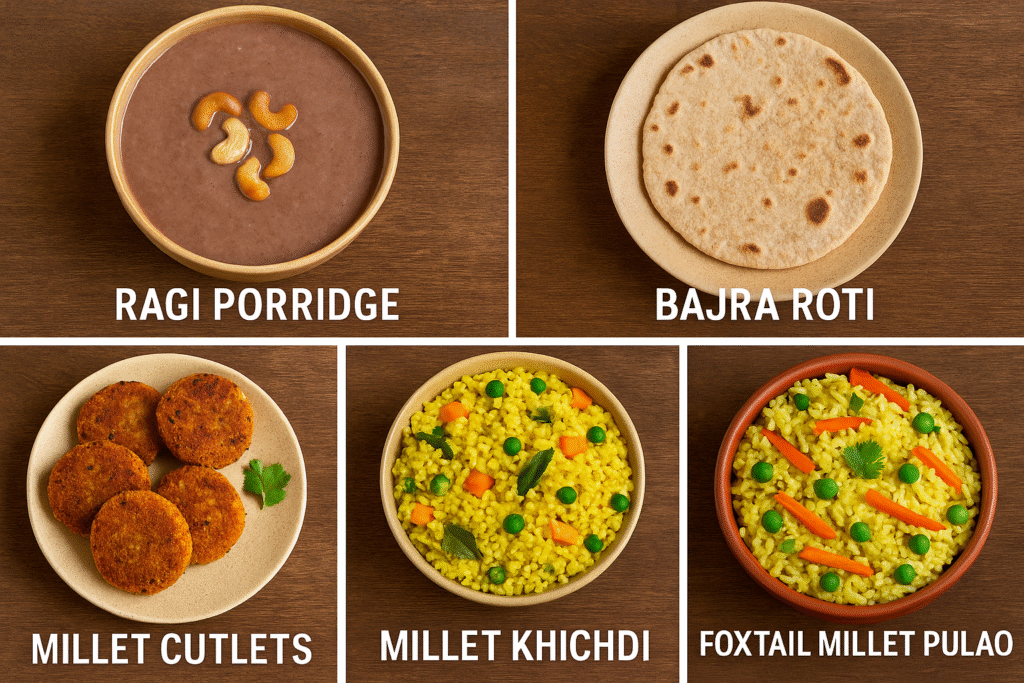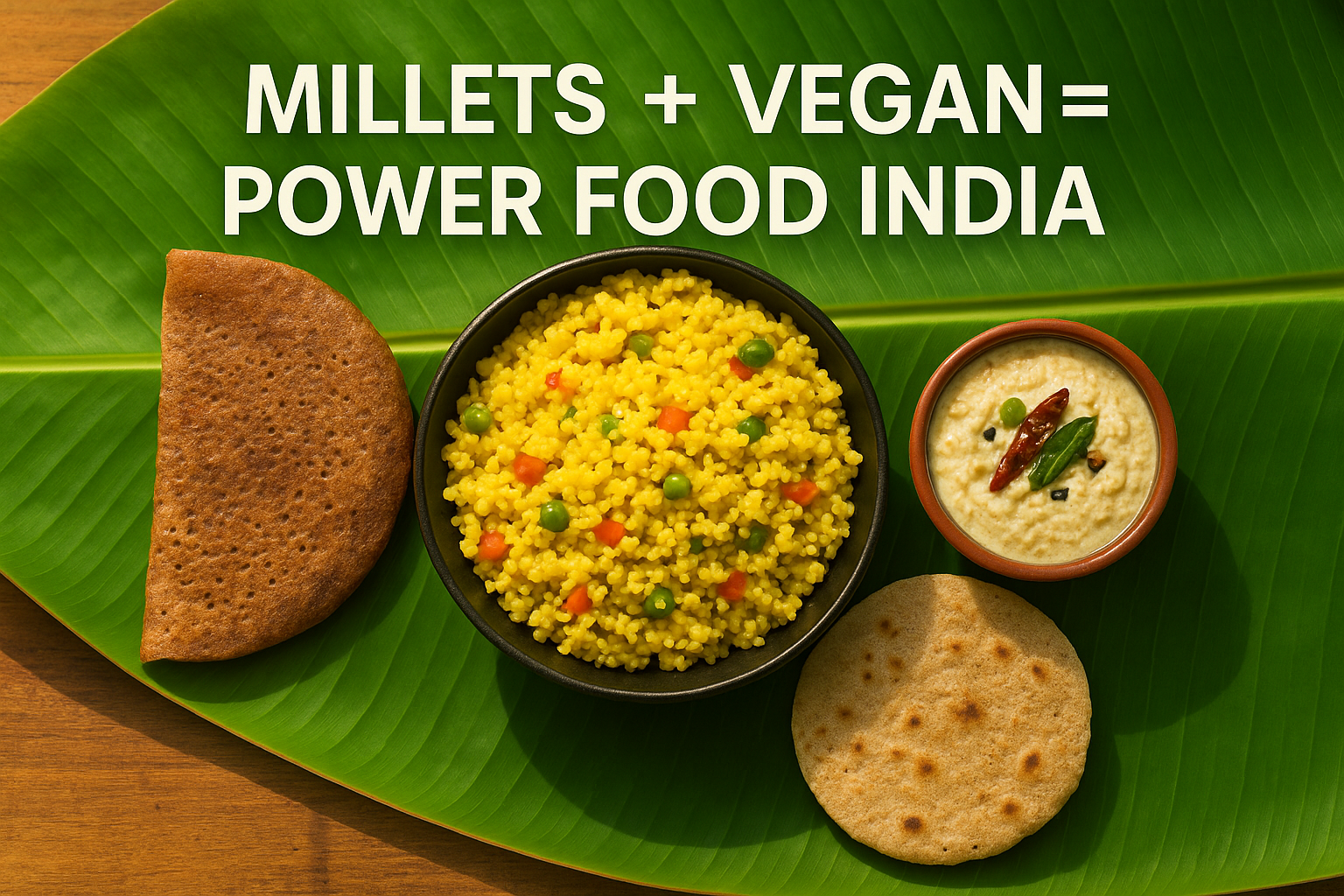Millets have been part of the Indian plate since ancient days, though they somehow took a backseat when rice and wheat came into the picture. Now, they’re making a comeback, especially among vegan diet followers in India who look for food that’s both plant-based and rich in nutrients. These tiny grains are loaded with fibre, protein, calcium, and antioxidants that support a complete plant-based diet.
People often think millets are just one kind, but India actually has more than a dozen varieties. You’ll find ragi (finger millet), bajra (pearl millet), jowar (sorghum), foxtail millet, and barnyard millet most often. Each brings a different texture and flavour to vegan dishes. When cooked the right way, they can taste as comforting as rice or wheat — maybe even better.
Millets also help vegans meet protein needs without touching animal products. A small bowl of cooked millet has both complex carbs and plant protein, keeping you full longer. That’s why nutritionists often call millets the “forgotten superfood” of India.
Choosing and storing millets for a plant-based pantry in Indian homes
Before you start using millets, you’ll need to understand how to choose and store them properly. There are unpolished, semi-polished, and polished versions. Try to pick unpolished millets since they hold more fibre and nutrients. A lot of Indian brands now clearly label this on packets.
Store them in airtight jars away from sunlight. If you live in a humid city like Mumbai or Chennai, keep them in the fridge to avoid moisture issues. These small steps will keep your Indian millets fresh and bug-free for months.
Here’s a quick look at common vegan-friendly Indian millets and how you can use them:
| Millet Type | Local Name | Best Used For | Key Nutrient |
|---|---|---|---|
| Finger Millet | Ragi | Dosa, malt drink, porridge | Calcium |
| Pearl Millet | Bajra | Roti, khichdi, upma | Iron |
| Foxtail Millet | Kangni | Salad, pulao, pongal | Protein |
| Barnyard Millet | Sanwa | Idli, kheer, porridge | Fibre |
| Sorghum | Jowar | Bhakri, dosa, chapati | Energy |
Try mixing these types through the week instead of sticking to just one. Keeps your meals interesting and varied.
Simple vegan breakfast, lunch, and dinner ideas using Indian millets
Starting your day with millets is easy. A ragi porridge with almond milk and banana can make a comforting morning bowl. Or go for millet idli or dosa — they taste quite similar to the regular version but are more filling.

For lunch, swap rice with foxtail millet pulao or barnyard millet khichdi. Both go well with dal, sabzi, or even simple curd (you can use plant-based curd). Dinner can be light — try bajra roti with vegetable curry or a jowar vegetable stir-fry bowl.
Snacks are where millets shine too. You can make ragi laddoos, millet cutlets, or roasted millet puffs for munching. These dishes taste homely, easy to digest, and align with vegan Indian eating habits.
How millets support vegan protein and essential micronutrients daily?
Many people worry about getting enough protein in a vegan diet, especially in India where most protein sources are lentils or soy. Millets quietly fill that gap. On average, millets give 7–12 g protein per 100 g and a better amino acid balance than rice. Pairing millets with legumes, lentils, or nuts creates a complete protein combo.
Millets also pack micronutrients like iron, magnesium, phosphorus, and even calcium, which are often low in plant-based diets. Ragi is known for its high calcium — almost ten times more than rice. Bajra provides iron, while foxtail millet is rich in zinc and magnesium. These help with bone strength, energy levels, and metabolism.
If you follow a vegan lifestyle in India, rotate millets with other grains and pulses. That way, you get full nutrition without needing supplements all the time.
One-day vegan Indian meal plan using a variety of local millets
Here’s a sample plan to see how easy it is to include millets through the day:
| Meal | Dish | Millet Used | Notes |
|---|---|---|---|
| Breakfast | Ragi porridge with plant milk and fruits | Finger millet | Add jaggery for sweetness |
| Mid-morning snack | Roasted millet chivda | Foxtail millet | Light and crunchy |
| Lunch | Bajra khichdi with mixed veggies | Pearl millet | Serve with vegan curd |
| Evening snack | Millet cutlets with chutney | Jowar | Great tea-time food |
| Dinner | Foxtail millet pulao with dal | Foxtail millet | Balanced and filling |
You can tweak it easily with local spices or seasonal produce.
Addressing taste, texture and cooking issues when switching to millets
A lot of people complain that millets taste earthy or have a different texture. That’s true if they’re not cooked the right way. Soak them for 4–5 hours before cooking. This softens the grain, removes bitter compounds, and improves digestion.
If you’re making roti with millet flour, mix a bit of warm water slowly till you get a pliable dough. Don’t roll it too thin; millets don’t have gluten, so they break easily. Once you learn the trick, it becomes second nature.
Fermentation helps too. For dosa or idli, fermenting the batter brings a mild tang and fluffy texture, masking that earthy flavour. It’s small hacks like these that make people stick to millets.
Environmental and health advantages of using millets for vegans in India
Millets are not only good for you but also for the planet. They grow easily in dry, semi-arid regions of India like Karnataka, Maharashtra, and Rajasthan, needing less water and fertilizer than rice or wheat. This makes them a sustainable grain for the Indian vegan community that’s mindful of eco-impact.
Health-wise, millets score better on the glycemic index, keeping blood sugar stable. They’re high in dietary fibre, which helps with digestion and cholesterol management. For vegans who rely on plant foods, fibre-rich grains like millets also support gut bacteria and nutrient absorption.
A lot of studies from Indian nutrition councils now promote millets in vegan diets for both health and sustainability reasons.
Practical everyday tips for cooking vegan millet recipes at home
Cooking millets well takes a bit of trial but once you know the basics, it’s easy. Some simple tips:
- Wash and soak the grains before cooking to cut cooking time
- Use two parts water for one part millet
- Add spices like cumin, mustard, turmeric for better flavour
- Mix millets with lentils or beans to make complete protein dishes
- Try plant-based versions of Indian favourites like ragi dosa, millet pongal, or bajra roti
You can also use millets to make desserts. Millet kheer with coconut milk or jaggery tastes great and fits a vegan lifestyle.
How much millet is ideal for vegans and what to watch for?
For most people, 1–2 servings of millets daily are good enough. That’s roughly one bowl of cooked millet or two millet rotis. Don’t rely only on millets though. Variety is key in a plant-based Indian diet. Include rice, quinoa, lentils, and vegetables too.
A few people may feel bloated in the beginning. That’s usually because of the high fibre. Start small, drink plenty of water, and gradually increase intake. If digestion seems off, try lightly roasting millets before cooking — it reduces the raw flavour and makes it gentler on the stomach.
Final thoughts on making millets a regular part of vegan food in India
Millets are India’s traditional grains that fit perfectly into the modern vegan Indian lifestyle. They’re nutrient-dense, gluten-free, protein-rich, and planet-friendly. Including them in your daily diet brings both health and environmental benefits.
Start simple — swap rice or wheat for millets once a day. Try different varieties like ragi, bajra, or jowar through your week. These small steps make a big difference over time. Once you get used to the texture and taste, you won’t miss your old grains much.
Eating millets isn’t a trend — it’s going back to what Indian kitchens have always known. A bowl of warm millet porridge or a bajra roti with sabzi is wholesome, comforting, and fits beautifully in a vegan diet in India.

